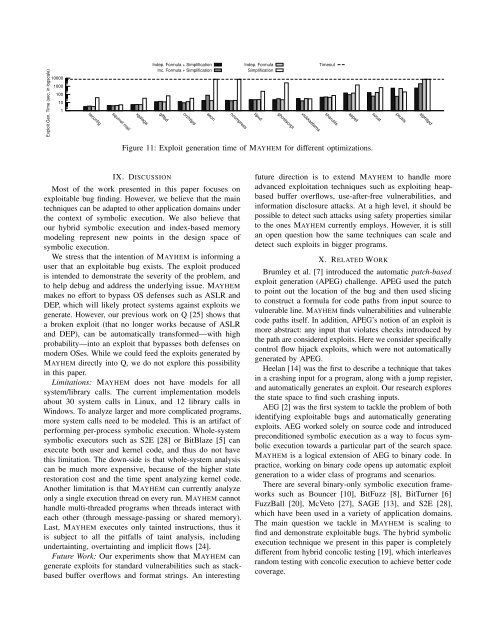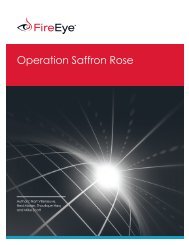Exploit Gen. Time (sec. in logscale)100001000100101iwconfigsquirrel mailxgalagaIndep. Formula + SimplificationInc. Formula + SimplificationglftpdorzhttpdaeonncompressIndep. FormulaSimplificationtipxdghostscriptxtokkaetamaTimeoutsharutilsaspellsocatpsutilsatphttpdFigure 11: Exploit generation time of MAYHEM for different optimizations.IX. DISCUSSIONMost of the work presented in this paper focuses onexploitable bug finding. However, we believe that the maintechniques can be adapted to other application domains underthe context of symbolic execution. We also believe thatour hybrid symbolic execution and index-based memorymodeling represent new points in the design space ofsymbolic execution.We stress that the intention of MAYHEM is informing auser that an exploitable bug exists. The exploit producedis intended to demonstrate the severity of the problem, andto help debug and address the underlying issue. MAYHEMmakes no effort to bypass OS defenses such as ASLR andDEP, which will likely protect systems against exploits wegenerate. However, our previous work on Q [25] shows thata broken exploit (that no longer works because of ASLRand DEP), can be automatically transformed—with highprobability—into an exploit that bypasses both defenses onmodern OSes. While we could feed the exploits generated byMAYHEM directly into Q, we do not explore this possibilityin this paper.Limitations: MAYHEM does not have models for allsystem/library calls. The current implementation modelsabout 30 system calls in Linux, and <strong>12</strong> library calls inWindows. To analyze larger and more complicated programs,more system calls need to be modeled. This is an artifact ofperforming per-process symbolic execution. Whole-systemsymbolic executors such as S2E [28] or BitBlaze [5] canexecute both user and kernel code, and thus do not havethis limitation. The down-side is that whole-system analysiscan be much more expensive, because of the higher staterestoration cost and the time spent analyzing kernel code.Another limitation is that MAYHEM can currently analyzeonly a single execution thread on every run. MAYHEM cannothandle multi-threaded programs when threads interact witheach other (through message-passing or shared memory).Last, MAYHEM executes only tainted instructions, thus itis subject to all the pitfalls of taint analysis, includingundertainting, overtainting and implicit flows [24].Future Work: Our experiments show that MAYHEM cangenerate exploits for standard vulnerabilities such as stackbasedbuffer overflows and format strings. An interestingfuture direction is to extend MAYHEM to handle moreadvanced exploitation techniques such as exploiting heapbasedbuffer overflows, use-after-free vulnerabilities, andinformation disclosure attacks. At a high level, it should bepossible to detect such attacks using safety properties similarto the ones MAYHEM currently employs. However, it is stillan open question how the same techniques can scale anddetect such exploits in bigger programs.X. RELATED WORKBrumley et al. [7] introduced the automatic patch-basedexploit generation (APEG) challenge. APEG used the patchto point out the location of the bug and then used slicingto construct a formula for code paths from input source tovulnerable line. MAYHEM finds vulnerabilities and vulnerablecode paths itself. In addition, APEG’s notion of an exploit ismore abstract: any input that violates checks introduced bythe path are considered exploits. Here we consider specificallycontrol flow hijack exploits, which were not automaticallygenerated by APEG.Heelan [14] was the first to describe a technique that takesin a crashing input for a program, along with a jump register,and automatically generates an exploit. Our research exploresthe state space to find such crashing inputs.AEG [2] was the first system to tackle the problem of bothidentifying exploitable bugs and automatically generatingexploits. AEG worked solely on source code and introducedpreconditioned symbolic execution as a way to focus symbolicexecution towards a particular part of the search space.MAYHEM is a logical extension of AEG to binary code. Inpractice, working on binary code opens up automatic exploitgeneration to a wider class of programs and scenarios.There are several binary-only symbolic execution frameworkssuch as Bouncer [10], BitFuzz [8], BitTurner [6]FuzzBall [20], McVeto [27], SAGE [13], and S2E [28],which have been used in a variety of application domains.The main question we tackle in MAYHEM is scaling tofind and demonstrate exploitable bugs. The hybrid symbolicexecution technique we present in this paper is completelydifferent from hybrid concolic testing [19], which interleavesrandom testing with concolic execution to achieve better codecoverage.
XI. CONCLUSIONWe presented MAYHEM, a tool for automatically findingexploitable bugs in binary (i.e., executable) programs in anefficient and scalable way. To this end, MAYHEM introducesa novel hybrid symbolic execution scheme that combinesthe benefits of existing symbolic execution techniques (bothonline and offline) into a single system. We also present indexbasedmemory modeling, a technique that allows MAYHEMto discover more exploitable bugs at the binary-level. Weused MAYHEM to analyze 29 applications and automaticallyidentified and demonstrated 29 exploitable vulnerabilities.XII. ACKNOWLEDGEMENTSWe thank our shepherd, Cristian Cadar and the anonymousreviewers for their helpful comments and feedback. Thisresearch was supported by a DARPA grant to CyLab atCarnegie Mellon University (N11AP20005/D11AP00262), aNSF Career grant (CNS0953751), and partial CyLab AROsupport from grant DAAD19-02-1-0389 and W911NF-09-1-0273. The content of the information does not necessarilyreflect the position or the policy of the Government, and noofficial endorsement should be inferred.REFERENCES[1] “Orzhttpd, a small and high performance http server,”http://code.google.com/p/orzhttpd/.[2] T. Avgerinos, S. K. Cha, B. L. T. Hao, and D. Brumley, “AEG:Automatic exploit generation,” in Proc. of the Network andDistributed System Security Symposium, Feb. 2011.[3] D. Babić, L. Martignoni, S. McCamant, and D. Song,“Statically-Directed Dynamic Automated Test Generation,” inInternational Symposium on Software Testing and Analysis.New York, NY, USA: ACM Press, 2011, pp. <strong>12</strong>–22.[4] G. Balakrishnan and T. Reps, “Analyzing memory accessesin x86 executables.” in Proc. of the International Conferenceon Compiler Construction, 2004.[5] “BitBlaze binary analysis project,”http://bitblaze.cs.berkeley.edu, 2007.[6] BitTurner, “BitTurner,” http://www.bitturner.com.[7] D. Brumley, P. Poosankam, D. Song, and J. Zheng, “Automaticpatch-based exploit generation is possible: Techniques andimplications,” in Proc. of the IEEE Symposium on Securityand Privacy, May 2008.[8] J. Caballero, P. Poosankam, S. McCamant, D. Babic, andD. Song, “Input generation via decomposition and re-stitching:Finding bugs in malware,” in Proc. of the ACM Conference onComputer and Communications Security, Chicago, IL, October2010.[9] C. Cadar, D. Dunbar, and D. Engler, “KLEE: Unassistedand automatic generation of high-coverage tests for complexsystems programs,” in Proc. of the USENIX Symposium onOperating System Design and Implementation, Dec. 2008.[10] M. Costa, M. Castro, L. Zhou, L. Zhang, and M. Peinado,“Bouncer: Securing software by blocking bad input,” inSymposium on Operating Systems Principles, Oct. 2007.[11] J. R. Crandall and F. Chong, “Minos: Architectural supportfor software security through control data integrity,” in Proc.of the International Symposium on Microarchitecture, Dec.2004.[<strong>12</strong>] L. M. de Moura and N. Bjørner, “Z3: An efficient smt solver,”in TACAS, 2008, pp. 337–340.[13] P. Godefroid, M. Levin, and D. Molnar, “Automated whiteboxfuzz testing,” in Proc. of the Network and Distributed SystemSecurity Symposium, Feb. 2008.[14] S. Heelan, “Automatic Generation of Control Flow HijackingExploits for Software Vulnerabilities,” Oxford University, Tech.Rep. MSc Thesis, 2009.[15] I. Jager, T. Avgerinos, E. J. Schwartz, and D. Brumley, “BAP:A binary analysis platform,” in Proc. of the Conference onComputer Aided Verification, 2011.[16] J. King, “Symbolic execution and program testing,” Communicationsof the ACM, vol. 19, pp. 386–394, 1976.[17] Launchpad, https://bugs.launchpad.net/ubuntu, open bugs inUbuntu. Checked 03/04/<strong>12</strong>.[18] C.-K. Luk, R. Cohn, R. Muth, H. Patil, A. Klauser, G. Lowney,S. Wallace, V. J. Reddi, and K. Hazelwood, “Pin: Buildingcustomized program analysis tools with dynamic instrumentation,”in Proc. of the ACM Conference on ProgrammingLanguage Design and Implementation, Jun. 2005.[19] R. Majumdar and K. Sen, “Hybrid concolic testing,” in Proc.of the ACM Conference on Software Engineering, 2007, pp.416–426.[20] L. Martignoni, S. McCamant, P. Poosankam, D. Song, andP. Maniatis, “Path-exploration lifting: Hi-fi tests for lo-fi emulators,”in Proc. of the International Conference on ArchitecturalSupport for Programming Languages and Operating Systems,London, UK, Mar. 20<strong>12</strong>.[21] A. Moser, C. Kruegel, and E. Kirda, “Exploring multipleexecution paths for malware analysis,” in Proc. of the IEEESymposium on Security and Privacy, 2007.[22] T. Newsham, “Format string attacks,” Guardent, Inc., Tech.Rep., 2000.[23] J. Newsome and D. Song, “Dynamic taint analysis forautomatic detection, analysis, and signature generation ofexploits on commodity software,” in Proc. of the Network andDistributed System Security Symposium, Feb. 2005.[24] E. J. Schwartz, T. Avgerinos, and D. Brumley, “All you everwanted to know about dynamic taint analysis and forwardsymbolic execution (but might have been afraid to ask),” inProc. of the IEEE Symposium on Security and Privacy, May2010, pp. 317–331.[25] E. J. Schwartz, T. Avgerinos, and D. Brumley, “Q: Exploithardening made easy,” in Proc. of the USENIX SecuritySymposium, 2011.[26] K. Sen, D. Marinov, and G. Agha, “CUTE: A concolic unittesting engine for C,” in Proc. of the ACM Symposium on theFoundations of Software Engineering, 2005.[27] A. V. Thakur, J. Lim, A. Lal, A. Burton, E. Driscoll, M. Elder,T. Andersen, and T. W. Reps, “Directed proof generation formachine code,” in CAV, 2010, pp. 288–305.[28] G. C. Vitaly Chipounov, Volodymyr Kuznetsov, “S2E: Aplatform for in-vivo multi-path analysis of software systems,”in Proc. of the International Conference on ArchitecturalSupport for Programming Languages and Operating Systems,2011, pp. 265–278.



